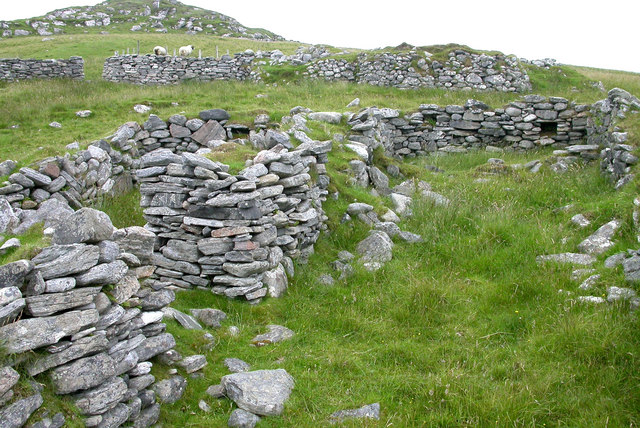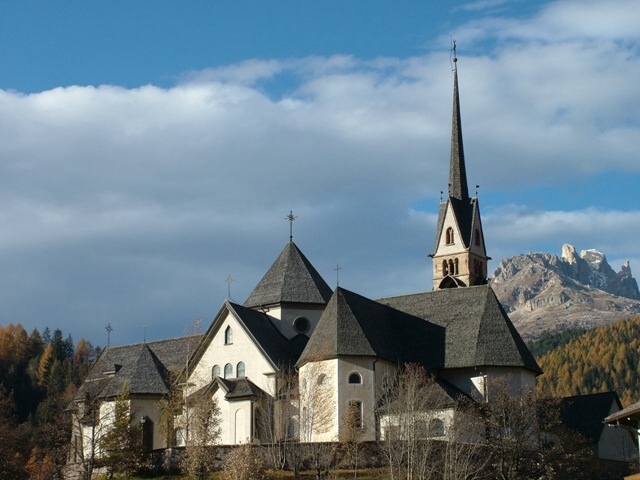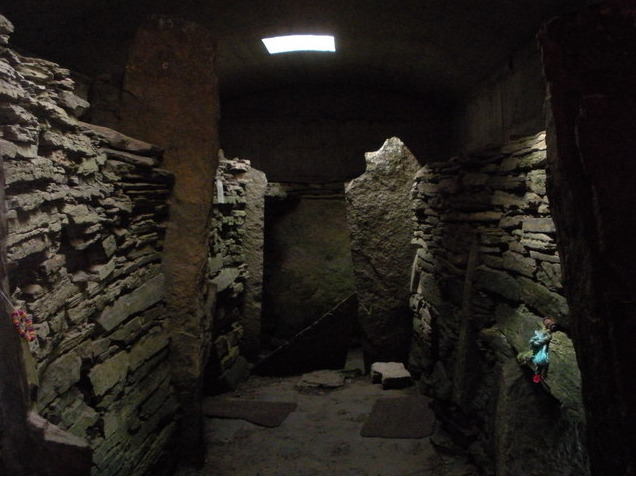|
Lamb Holm
Lamb Holm is a small uninhabited island in Orkney, Scotland. The Italian Chapel, constructed during the Second World War, is the island's main attraction. Lamb Holm is classified by the National Records of Scotland as an uninhabited island that "had no usual residents at the time of either the 2001 or 2011 censuses." Geography Lamb Holm lies in Holm Sound, one of the eastern entrances to Scapa Flow, between Mainland, Orkney and the island of Burray, It is in area. The Churchill Barriers carry the road from South Ronaldsay to Mainland, Orkney. Lamb Holm is connected to Glimps Holm, to the southwest, by Barrier number 2, and to Mainland by Barrier number 1. The quarry used to build the Churchill Barriers has now been flooded and converted into a fish farm. On the northwest of the island, on the shore of St Mary's Bay, are the remains of a prehistoric settlement which have been designated as a scheduled monument. There is a Bronze Age Barrow mound on the island named as "La ... [...More Info...] [...Related Items...] OR: [Wikipedia] [Google] [Baidu] |
Mainland, Orkney
The Mainland, also known as Pomona, is the main island of Orkney, Scotland. Both of Orkney's burghs, Kirkwall and Stromness, lie on the island, which is also the heart of Orkney's ferry and air connections. Seventy-five per cent of Orkney's population live on the island, which is more densely populated than the other islands of the archipelago. The lengthy history of the island's occupation has provided numerous important archaeological sites and the sandstone bedrock provides a platform for fertile farmland. There is an abundance of wildlife, especially seabirds. Etymology The name Mainland is a Language change, corruption of the Old Norse . Formerly the island was also known as meaning 'horse island'. The island is sometimes referred to as ''Pomona (mythology), Pomona'' (or ''Pomonia''), a name that stems from a 16th-century mis-translation by George Buchanan.Buchanan, George (1582''Rerum Scoticarum Historia: The First Book''The University of California, Irvine. Revised 8 Marc ... [...More Info...] [...Related Items...] OR: [Wikipedia] [Google] [Baidu] |
Glimps Holm
Glimps Holm or Glims Holm is a small uninhabited islet in Orkney, Scotland. It lies in Holm Sound, one of the eastern entrances to Scapa Flow, between Mainland Orkney and the island of Burray. Nearby is Lamb Holm. The two are linked by Churchill Barrier No. 2, one of a series of causeways built during World War II World War II or the Second World War (1 September 1939 – 2 September 1945) was a World war, global conflict between two coalitions: the Allies of World War II, Allies and the Axis powers. World War II by country, Nearly all of the wo ... to protect Scapa Flow from U-boats. Barrier No. 3 links Glimps Holm to Burray. Footnotes Uninhabited islands of Orkney {{Orkney-geo-stub ... [...More Info...] [...Related Items...] OR: [Wikipedia] [Google] [Baidu] |
List Of Islands Of Scotland
This is a list of islands of Scotland, the mainland of which is part of the island of Great Britain. Also included are various other related tables and lists. The definition of an offshore island used in this list is "land that is surrounded by seawater on a daily basis, but not necessarily at all stages of the tide, excluding human devices such as bridges and causeways". Scotland has around 900 offshore islands, most of which are to be found in four main groups: Shetland Islands, Shetland, Orkney Islands, Orkney, and the Hebrides, sub-divided into the Inner Hebrides and Outer Hebrides. There are also clusters of islands in the Firth of Clyde, Firth of Forth, and Solway Firth, and numerous small islands within the many bodies of fresh water in Scotland including Loch Lomond and Loch Maree. The largest island is Lewis and Harris, which extends to , and there are a further 200 islands which are greater than in area. Of the remainder, several, such as Staffa and the Flannan Isles, ... [...More Info...] [...Related Items...] OR: [Wikipedia] [Google] [Baidu] |
Italian Chapel
The Italian Chapel is a highly ornate Catholic chapel on Lamb Holm in Orkney, Scotland. It was built during the Second World War by Italian prisoners of war, who were housed on the previously uninhabited island while they constructed the Churchill Barriers to the east of Scapa Flow. Only the concrete foundations of the other buildings of the prisoner-of-war camp survive. The chapel was not completed until after the end of the war, and was restored in the 1960s and again in the 1990s. It is a popular tourist attraction, and a Category A listed building. It is in the Roman Catholic Parish of Our Lady & St Joseph in Orkney, part of the Roman Catholic Diocese of Aberdeen. Mass is held in the chapel on the first Sunday of the summer months (April–September). Construction 550 Italian prisoners of war, captured in North Africa during the Second World War, were brought to Orkney in 1942. They worked on the construction of the Churchill Barriers, four causeways created to block ... [...More Info...] [...Related Items...] OR: [Wikipedia] [Google] [Baidu] |
Moena
Moena ( Ladin: ''Moéna'') is a ''comune'' (municipality) and a village in Trentino in the northern Italian region Trentino-Alto Adige/Südtirol, located about northeast of Trento. It is the largest comune in the Fassa Valley. In the census of 2001, 1,967 inhabitants out of 2,602 (75.6%) declared Ladin as their native language. Geography Moena lies on the Avisio, a tributary of the Adige river. The municipality borders with Falcade, Nova Levante, Sèn Jan di Fassa, Predazzo, Soraga and Tonadico. It counts the hamlets (''frazioni'') of Forno, Medil, San Pellegrino, Penia, Someda and Sorte. Main sights Sights include the church of ''San Vigilio'', with a Gothic bell tower and 18th-century paintings by Valentino Rovisi, and the ancient church of San Volfango, with 15th-century frescoes and a Baroque ceiling by Giovanni Guadagnini (17th century). The festival ''La Turchia'' takes place once a year during the 19th of August until the 21st. According to Turkish tradition, ... [...More Info...] [...Related Items...] OR: [Wikipedia] [Google] [Baidu] |
Listed Building
In the United Kingdom, a listed building is a structure of particular architectural or historic interest deserving of special protection. Such buildings are placed on one of the four statutory lists maintained by Historic England in England, Historic Environment Scotland in Scotland, in Wales, and the Historic Environment Division of the Department for Communities in Northern Ireland. The classification schemes differ between England and Wales, Scotland, and Northern Ireland (see sections below). The term has also been used in the Republic of Ireland, where buildings are protected under the Planning and Development Act 2000, although the statutory term in Ireland is "Record of Protected Structures, protected structure". A listed building may not be demolished, extended, or altered without permission from the local planning authority, which typically consults the relevant central government agency. In England and Wales, a national amenity society must be notified of any work to ... [...More Info...] [...Related Items...] OR: [Wikipedia] [Google] [Baidu] |
World War II
World War II or the Second World War (1 September 1939 – 2 September 1945) was a World war, global conflict between two coalitions: the Allies of World War II, Allies and the Axis powers. World War II by country, Nearly all of the world's countries participated, with many nations mobilising all resources in pursuit of total war. Tanks in World War II, Tanks and Air warfare of World War II, aircraft played major roles, enabling the strategic bombing of cities and delivery of the Atomic bombings of Hiroshima and Nagasaki, first and only nuclear weapons ever used in war. World War II is the List of wars by death toll, deadliest conflict in history, causing World War II casualties, the death of 70 to 85 million people, more than half of whom were civilians. Millions died in genocides, including the Holocaust, and by massacres, starvation, and disease. After the Allied victory, Allied-occupied Germany, Germany, Allied-occupied Austria, Austria, Occupation of Japan, Japan, a ... [...More Info...] [...Related Items...] OR: [Wikipedia] [Google] [Baidu] |
Scheduled Monument
In the United Kingdom, a scheduled monument is a nationally important archaeological site or historic building, given protection against unauthorised change. The various pieces of legislation that legally protect heritage assets from damage, visual disturbance, and destruction are grouped under the term "Designation (heritage assets), designation". The protection provided to scheduled monuments is given under the Ancient Monuments and Archaeological Areas Act 1979, which is a different law from that used for listed buildings (which fall within the town and country planning system). A heritage asset is a part of the historic environment that is valued because of its historic, archaeological, architectural or artistic interest. Only some of these are judged to be important enough to have extra legal protection through designation. There are about 20,000 scheduled monuments in England representing about 37,000 heritage assets. Of the tens of thousands of scheduled monuments in the UK ... [...More Info...] [...Related Items...] OR: [Wikipedia] [Google] [Baidu] |
Fish Farm
Fish farming or pisciculture involves commercial breeding of fish, most often for food, in fish tanks or artificial enclosures such as fish ponds. It is a particular type of aquaculture, which is the controlled cultivation and harvesting of aquatic animals such as fish, crustaceans, molluscs and so on, in natural or pseudo-natural environments. A facility that releases juvenile fish into the wild for recreational fishing or to supplement a species' natural numbers is generally referred to as a fish hatchery. Worldwide, the most important fish species produced in fish farming are carp, catfish, salmon and tilapia. Global demand is increasing for dietary fish protein, which has resulted in widespread overfishing in wild fisheries, resulting in significant decrease in fish stocks and even complete depletion in some regions. Fish farming allows establishment of artificial fish colonies that are provided with sufficient feeding, protection from natural predators and competitive ... [...More Info...] [...Related Items...] OR: [Wikipedia] [Google] [Baidu] |
South Ronaldsay
South Ronaldsay (, also , ) is one of the Orkney Islands off the north coast of Scotland. It is linked to the Orkney Mainland by the Churchill Barriers, running via Burray, Glimps Holm and Lamb Holm. Name Along with North Ronaldsay, the island is named after Rögnvald Kali Kolsson, St Ronald. The original name from which the English name derives, ''Rǫgnvaldsey'', comes from Old Norse; ''Rǫgnvalds'' ("Ronald's") + ''ey'' ("island"). Geography and geology With an area of , it is the fourth largest of the Orkney islands after The Mainland, Orkney, The Mainland, Hoy, Orkney, Hoy and Sanday, Orkney, Sanday. Ferry, Ferries sail from Burwick, Orkney, Burwick on the island to John o' Groats on the Scottish mainland and from St Margaret's Hope to Gills Bay.Wenham, Sheena "The South Isles" in Omand (2003) p. 212. South Ronaldsay's main village is St Margaret's Hope, Orkney's third largest settlement. It is named either after Margaret, Maid of Norway, the heir to the Scottish throne w ... [...More Info...] [...Related Items...] OR: [Wikipedia] [Google] [Baidu] |
Orkney
Orkney (), also known as the Orkney Islands, is an archipelago off the north coast of mainland Scotland. The plural name the Orkneys is also sometimes used, but locals now consider it outdated. Part of the Northern Isles along with Shetland, Orkney is 10 miles (16 km) north of Caithness and has about 70 islands, of which 20 are inhabited.Haswell-Smith (2004) pp. 336–403. The largest island, the Mainland, Orkney, Mainland, has an area of , making it the List of islands of Scotland, sixth-largest Scottish island and the List of islands of the British Isles, tenth-largest island in the British Isles. Orkney's largest settlement, and also its administrative centre, is Kirkwall. Orkney is one of the 32 Subdivisions of Scotland, council areas of Scotland, as well as a Orkney (Scottish Parliament constituency), constituency of the Scottish Parliament, a Lieutenancy areas of Scotland, lieutenancy area, and an counties of Scotland, historic county. The local council is Orkney I ... [...More Info...] [...Related Items...] OR: [Wikipedia] [Google] [Baidu] |
Churchill Barriers
The Churchill Barriers are four causeways in the Orkney islands with a total length of . They link the Orkney Mainland in the north to the island of South Ronaldsay via Burray and the two smaller islands of Lamb Holm and Glimps Holm. The barriers were built between May 1940 and September 1944, primarily as naval defences to protect the anchorage at Scapa Flow, but since 12 May 1945 they serve as road links between the islands. The two southern barriers, Glimps Holm to Burray and Burray to South Ronaldsay, are Category A listed. History On 14 October 1939, the Royal Navy battleship HMS ''Royal Oak'' was sunk at her moorings within the natural harbour of Scapa Flow, by the under the command of Günther Prien. ''U-47'' had entered Scapa Flow through Holm Sound, one of several eastern entrances to Scapa Flow. The eastern passages were protected by measures including sunken block ships, booms and anti-submarine nets, but ''U-47'' entered at night at high tide by navigatin ... [...More Info...] [...Related Items...] OR: [Wikipedia] [Google] [Baidu] |










